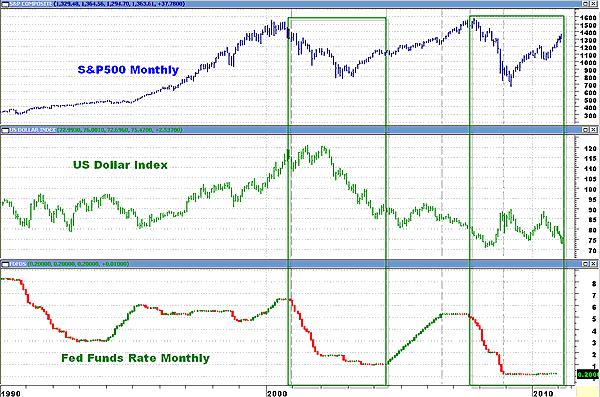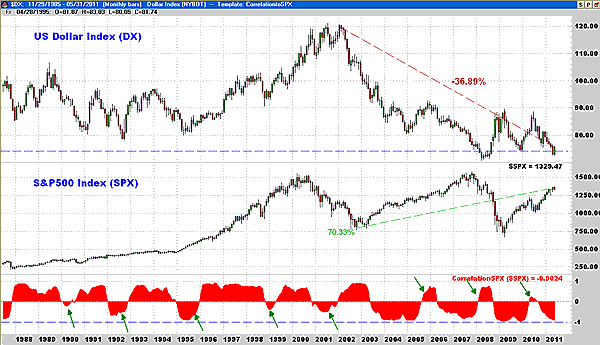
HOT TOPICS LIST
- MACD
- Fibonacci
- RSI
- Gann
- ADXR
- Stochastics
- Volume
- Triangles
- Futures
- Cycles
- Volatility
- ZIGZAG
- MESA
- Retracement
- Aroon
INDICATORS LIST
LIST OF TOPICS
PRINT THIS ARTICLE
by Matt Blackman
According to economist David Rosenberg, there is an 86% correlation between the size of the Federal Reserve balance sheet (read: stimulus programs) and the S&P 500. Quantitative Easing 2 ends in June. So what then?
Position: N/A
Matt Blackman
Matt Blackman is a full-time technical and financial writer and trader. He produces corporate and financial newsletters, and assists clients in getting published in the mainstream media. He is the host of TradeSystemGuru.com. Matt has earned the Chartered Market Technician (CMT) designation. Find out what stocks and futures Matt is watching on Twitter at www.twitter.com/RatioTrade
PRINT THIS ARTICLE
CORRELATION ANALYSIS
Asking The Trillion-Dollar Question: Will There Be A QE3?
05/18/11 10:18:49 AMby Matt Blackman
According to economist David Rosenberg, there is an 86% correlation between the size of the Federal Reserve balance sheet (read: stimulus programs) and the S&P 500. Quantitative Easing 2 ends in June. So what then?
Position: N/A
| Since the credit crisis and subsequent meltdown in stocks in 2007-08, we have become increasingly beholden to monetary policy to support stock markets. In fact, the rationale for initiating the most expensive stimulus programs in history in 2008 was to prevent a complete financial collapse. Quantitative Easing 1 (QE1) averted that threat at least temporarily, but when it was over, the economy was still weak and real unemployment remained at near-Great Depression era highs. |
| As a result, Ben Bernanke and his team of central bankers kept the ball rolling with an additional $600 billion in stimulus that became known as QE2. Most of that money is now gone and QE2 is officially slated to end June 30. (It may also interest the reader to know that the Federal Reserve has been buying 70% of Treasuries, which has bloated its balance sheet even further; see http://www.pimco.com/EN/Insights/Pages/Two-Bits-Four-Bits-Six-Bits-a-Dollar.aspx). But although interest rates remain stuck near zero, like a drug addict forced into cold turkey rehab, the markets have become addicted to printed cash and have not responded positively to the news that stimulus is ending, as demonstrated by the recent weak performance. See Figure 1. |

|
| FIGURE 1: COMPARISONS. Relationships between the S&P 500 Index, US Dollar Index, and the Fed funds overnight rate compared on a monthly basis. For the most part, the SPX has either a falling dollar or low interest rates to rally. |
| Graphic provided by: MetaStock. |
| |
| In a nutshell, the economy has slowly but surely recovered as long as stimulus programs were under way, but like the party around a punchbowl, once it is taken away, the recovery and stock markets have stalled. See Figure 2. |

|
| FIGURE 2: US DOLLAR INDEX VS. S&P 500. Here's the monthly chart of the US Dollar Index versus the S&P 500 with the correlation between the two in the lower subgraph (red). Note that until 2001, the correlation was more positive but since 2001, it has turned decidedly negative. |
| Graphic provided by: Chart courtesy of www.GenesisFT.com. |
| |
| Given the correlation between stimulus programs and the economy and markets, will the Fed sit on its hands if both continue to fall? If the government had the luxury of time to let the recovery truly take hold without stimulus, we might venture a guess that yes, the Fed would not (nor should it) intervene. At some point, the economy must be allowed to recover without taxpayer help. |
| But given that this is year 3 in the election cycle and the fact that governments over the last 100-plus years have traditionally kicked the stimulus spigots onto high for years 3 and 4 (election year) to get reelected (see http://tradesystemguru.com/content/view/305/61/), Bernanke et al. would be fighting significant political pressure (read: President Obama and the Democrats) to fill the punch bowl for the election. And given the recent history and willingness of the Fed to please, the likelihood of them not doing so again must be considered near zero. Given the impact that QE1 and QE2 have had on commodity prices (real inflation), the Fed is in a very awkward position of trying to balance growth with inflation and over the last two decades have increasingly taken the dovish side on inflation, but that is another story. |
Matt Blackman is a full-time technical and financial writer and trader. He produces corporate and financial newsletters, and assists clients in getting published in the mainstream media. He is the host of TradeSystemGuru.com. Matt has earned the Chartered Market Technician (CMT) designation. Find out what stocks and futures Matt is watching on Twitter at www.twitter.com/RatioTrade
| Company: | TradeSystemGuru.com |
| Address: | Box 2589 |
| Garibaldi Highlands, BC Canada | |
| Phone # for sales: | 604-898-9069 |
| Fax: | 604-898-9069 |
| Website: | www.tradesystemguru.com |
| E-mail address: | indextradermb@gmail.com |
Traders' Resource Links | |
| TradeSystemGuru.com has not added any product or service information to TRADERS' RESOURCE. | |
Click here for more information about our publications!
PRINT THIS ARTICLE

|

Request Information From Our Sponsors
- StockCharts.com, Inc.
- Candle Patterns
- Candlestick Charting Explained
- Intermarket Technical Analysis
- John Murphy on Chart Analysis
- John Murphy's Chart Pattern Recognition
- John Murphy's Market Message
- MurphyExplainsMarketAnalysis-Intermarket Analysis
- MurphyExplainsMarketAnalysis-Visual Analysis
- StockCharts.com
- Technical Analysis of the Financial Markets
- The Visual Investor
- VectorVest, Inc.
- Executive Premier Workshop
- One-Day Options Course
- OptionsPro
- Retirement Income Workshop
- Sure-Fire Trading Systems (VectorVest, Inc.)
- Trading as a Business Workshop
- VectorVest 7 EOD
- VectorVest 7 RealTime/IntraDay
- VectorVest AutoTester
- VectorVest Educational Services
- VectorVest OnLine
- VectorVest Options Analyzer
- VectorVest ProGraphics v6.0
- VectorVest ProTrader 7
- VectorVest RealTime Derby Tool
- VectorVest Simulator
- VectorVest Variator
- VectorVest Watchdog
